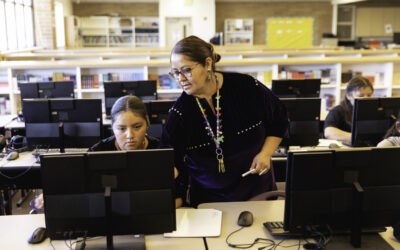Computational thinking has become important to teaching problem solving in education because it empowers students with processes to develop strategic solutions to complex problems, essentially “leveling up” their skills, or creating algorithms that can make future processes more effective. This enables students to take on more complex challenges and prepare for real-world applications.
Decomposition in Computational Thinking
While the process of computational thinking is multifaceted, there is one key to computational thinking that is essential for success: decomposition. Decomposition is the process of breaking a complex task or problem into smaller, more manageable pieces. From this decomposition, students can eliminate unnecessary information, identify patterns and begin the process of identifying which parts of the problem are most important, how to solve or complete each step, and how those parts can be put together for a clear and unified step-by-step solution.
Why is the Decomposition Technique Required in Computational Thinking?
The technique of decomposition is required in computational thinking because it breaks complex tasks into subtasks while developing a sequentially-based understanding of the problem. This allows unnecessary information to be discarded, patterns to be identified, relevant information to be extracted and the process of step-by-step resolution to be defined for a more effective problem-solving process.
By definition, computational thinking is the process of tackling complex problems and finding a clear, step-by-step solution that can be replicated. Decomposition, therefore, is essential to this process as it includes breaking a task into several sub-tasks, helping to align the task to a step-by-step solution.
Another reason decomposition in computational thinking is important is because it allows each subtask to be examined more closely. This not only helps to categorize information as essential or non-essential, but also empowers the problem-solver with a better ability to analyze each specific part of the task or challenge to more effectively develop a reasonable solution.
Examples of Decomposition in Computational Thinking
Below are some real-world examples of utilizing decomposition in computational thinking:
- You have to clean your house. Instead of facing the task as a whole, you practice decomposition by breaking the task into a to-do list with multiple subtasks.
- To build shelves for a storage space, you practice decomposition by measuring the space, creating a blueprint or plan to determine the size of the shelves and the materials you need to accomplish the task. Next, you purchase the supplies and cut the lumber to size, then install one wall of shelves at a time.
- In science, to prove or disprove a hypothesis, you practice decomposition by creating subtasks including background research, observation, generating a hypothesis, determining which variables to test, performing experiments and drawing a conclusion.
Final Thoughts
Consider how often computational thinking appears in your everyday life. Do you naturally use decomposition and computational thinking to resolve a challenge? For more information about computational thinking and how they apply to students, explore some of our most recent articles:
Algorithmic Thinking: A Critical Skill for Today’s Students
For many people, “algorithmic thinking” conjures visions of a Good Will Hunting whiteboard with extensive equations and symbols long forgotten in our educational memory. For others familiar with coding curriculum, it’s an important step in the computer programming...
Navigating a Successful Digital Curriculum Implementation
Implementing a digital curriculum might seem overwhelming, but with the right strategy and teamwork, you can ensure a smooth and successful rollout. Here’s how to get started: 1. Assess Your Current Situation Begin by evaluating your district’s technology...
Magic Behind Teaching and Learning
The teaching and learning process can be magical for educators and students alike. However, creating an effective learning environment requires purposeful planning, an understanding of educational theories, and mastery of digital tools. Let's explore how to bridge the...
How Were the TEKS Created & What is Its Significance?
The Texas Essential Knowledge and Skills (TEKS) framework details the educational standards in the state of Texas, providing a comprehensive outline of what students are expected to learn from kindergarten through 12th grade. This framework is essential not only for...
CIPA Compliance Made Easy with Learning.com
The Children’s Internet Protection Act (CIPA), enacted by Congress in 2000, addresses concerns about children’s access to harmful online content. It specifically applies to schools and libraries that receive discounts for Internet access through the E-rate program...
Students as Logical Thinkers: How Computer Science Teaches Real-World Skills
There is little debate that computer science education has become an imperative curriculum for future-ready students. From modern professions and innovations to home management and communication, the world is becoming increasingly technology-driven. Being able to...
The Digital Readiness Divide in Education
Following access and connectivity, the second digital divide refers to digital readiness, or the skillset that enables people to use technology as informed digital citizens, capable workers, and empowered learners. Studies on the Digital Readiness Divide The skill...
Pursuing Digital Access & Opportunity for All Students
While devices such as laptops and tablets have become significantly more common in schools since 2020, challenges persist in access, especially due to connectivity issues at school and at home. Asd students have gained more access to technology in schools,...
AI in Education: Leveraging Chat GPT in the Classroom
The introduction of ChatGPT into educational settings has sparked a vigorous debate regarding its ethical implications, primarily centered on concerns about plagiarism or using AI to “do the work” for students, leaving them with little real learning or understanding....
Student Engagement Models & Integrating Coding into Learning
With an emphasis on future-readiness sweeping the country, the conversation in education is shifting to how to prepare learners for the future of work. The same methods, mindsets and pedagogies that were utilized when the current educational system was created (during...
Teaching at the Intersection of CTE, STEM, and Career Readiness
Have you ever scrolled through LinkedIn, seeing the collection of connection suggestions from former high school classmates? If you’re like many people, you may have been struck by the oddity of seeing these people as branded career professionals. It’s entirely...
What Informs Elementary and Middle School Tech Curriculum?
Contrary to popular belief, students are not just “born” with technology skills. While we commonly observe them interacting daily with their computers and cell phones, that doesn’t necessarily mean they understand basic use, best practice, and safety risks. In fact,...

Learning.com Team
Staff Writers
Founded in 1999, Learning.com provides educators with solutions to prepare their students with critical digital skills. Our web-based curriculum for grades K-12 engages students as they learn keyboarding, online safety, applied productivity tools, computational thinking, coding and more.













